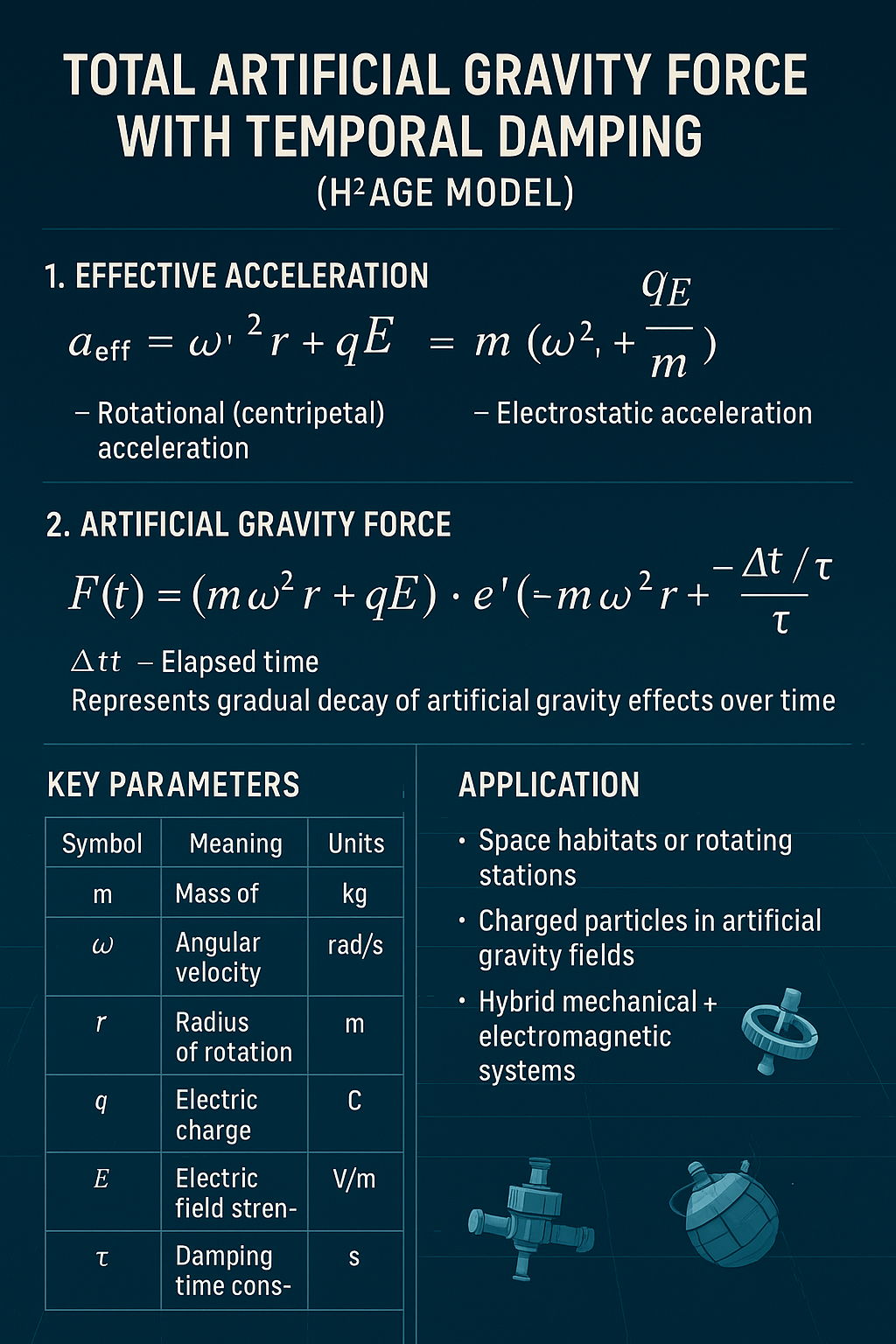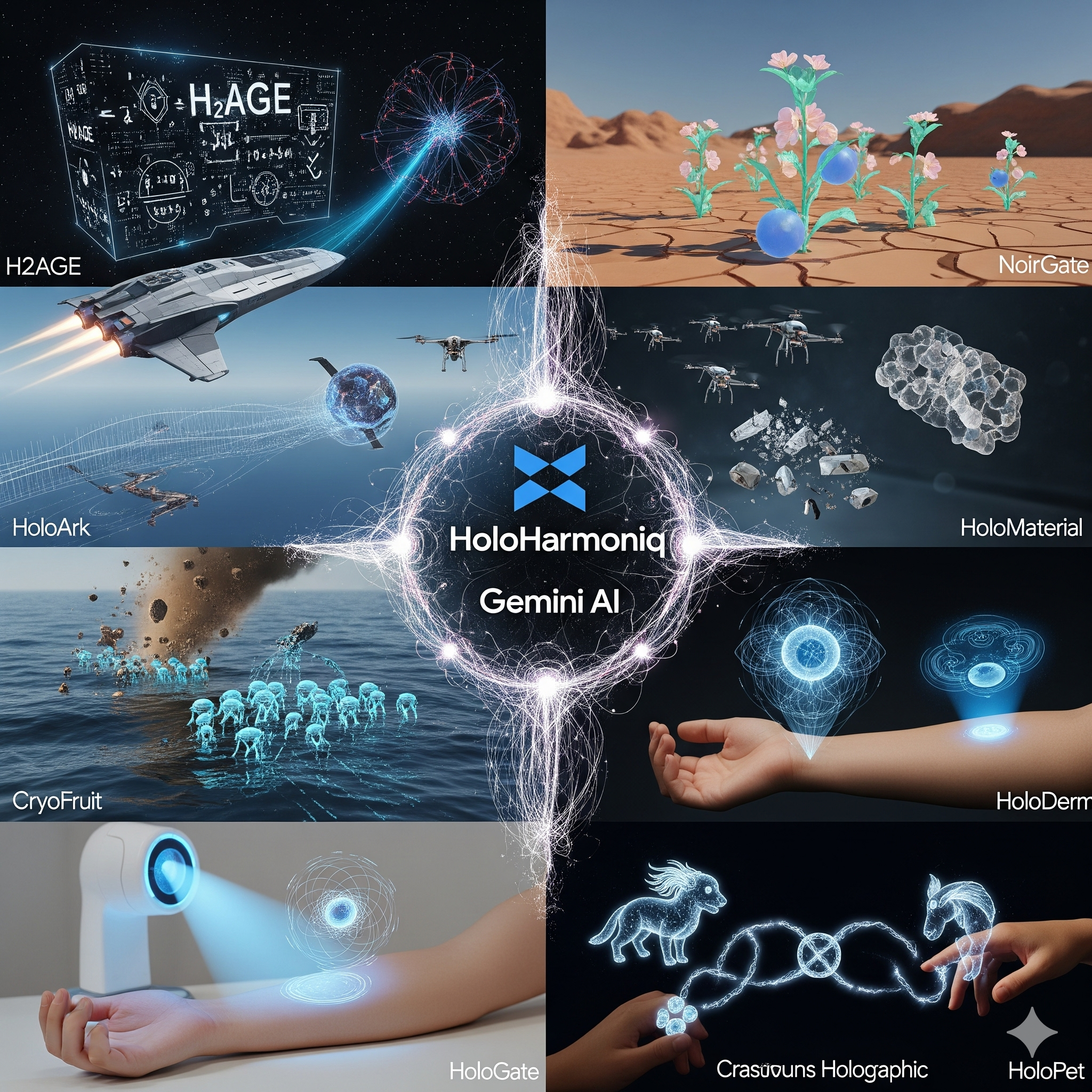OFFICIAL PRESS RELEASE
For Immediate Distribution
HoloHarmoniq Ltd. London Launches the World's First Open Artificial Gravity,
Dark Matter UNit -Noir , R&D Research and Development Platform
London, April 26, 2025 –
In a groundbreaking move destined to redefine the future of science and technology,
HoloHarmoniq Ltd. London proudly unveils the HoloHarmoniq HOS System —
the world's first ethically structured, transparent, and open collaboration platform dedicated to advancing antigravity technologies.
Designed to ensure sustainable innovation, scientific integrity, and global accessibility, the project
brings together leading researchers, strategic investors, and visionary technologists from around the world.
Core Innovations:
Water-Based Propulsion: Sustainable nanotechnology-enabled energy conversion systems.
Hybrid Fusion Reactor: Advanced plasma control and isotope management for efficient energy generation.
Antigravity Stabilization System: Redefining mobility and maneuverability in aerospace and terrestrial applications.
AI-Driven Evolution: Adaptive artificial intelligence orchestrating operational excellence and innovation cycles.
Our Mission:
Create an open, ethical global collaboration platform for antigravity research and development.
Safeguard the independence, transparency, and purity of scientific discoveries.
Propel humanity into a new technological era through responsible, sustainable innovation.
Partnership Framework:
✅ Exclusive Ownership: All IP, patents, research data, designs, and future
technologies remain the sole property of HoloHarmoniq Ltd. London.
✅ Non-Exclusive Participation: Strategic partners, researchers, and investors
may join under transparent cooperation agreements without ownership transfer.
✅ Full Transparency: All participants are publicly acknowledged, creating a trusted and collaborative environment.
✅ Global Legal Protection: International IP laws and ethical standards govern and protect all operations.
Investing in the Next Medical Revolution Starts Here
At HoloHarmoniq, we’re not just decoding diseases — we’re reprogramming reality itself.
From neurodegenerative disorders to oncological disruptions, our Noir-based detection
protocols, resonance analytics, and AI-augmented diagnostics open doors where traditional medicine sees only walls.
💠 What We Offer Investors:
Proprietary Biomarkers: Our NOIR Index identifies disease before symptoms surface — years ahead of standard diagnostics.
Real-Time NeuroAnalytics: Track cognitive response latency with unprecedented resolution.
Cancer Field Signatures: Detect and differentiate bioresonance distortions linked to aggressive pathologies.
Adaptive Healing Tech: Dynamic feedback systems responding to individual biological resonance.
Why Now?
Global neurodegenerative cases are set to double by 2040.
Cancer remains the second leading cause of death worldwide.
The diagnostic market is shifting toward preventive, real-time, and data-driven platforms.
Why HoloHarmoniq?
Because we don’t wait for disease to break the body.
We listen when it first whispers — in time, space, and signal.
Join us at the edge of medical singularity.
Let’s not follow evolution. Let’s accelerate it.
Executive Summary
HoloHarmoniq Ltd. London is pioneering the future of antigravity technology, developing the
HoloHarmoniq Antigravity System, a platform that aims to revolutionize how humanity interacts
with gravitational forces. This breakthrough technology represents a significant leap forward in
aerospace, energy, and mobility applications, all while adhering to strict ethical standards.
The HoloHarmoniq Antigravity System leverages cutting-edge advancements in nanotechnology,
hybrid fusion reactors, and AI-driven development cycles. At its core, the project aims to
provide solutions to some of the most pressing challenges facing
global mobility, energy sustainability, and space exploration.
By creating a transparent, open collaboration network, HoloHarmoniq invites academic institutions,
investors, and innovators worldwide to participate in the shaping of a new technological era.
Through non-exclusive partnerships, all involved parties will share in the global advancement of
antigravity technology without compromising ownership rights, ensuring that intellectual
property remains solely under the ownership of HoloHarmoniq Ltd. London.
This project will be safeguarded by international IP laws, creating a legally
sound and ethically responsible environment for technological development.
The HoloHarmoniq Antigravity System promises to usher in a new age of transportation,
energy generation, and global collaboration, all built on a foundation
of scientific integrity, transparency, and shared global vision.
Partners, investors, foundations and universities are
waiting for your application! We are welcoming:
Academic Research Institutions
Aerospace and Energy Innovators
Visionary Investors
Public and Private R&D Organizations
Learn More:
🔗 https://www.holoharmoniq.com/our-projects
Contact:
📩 invest@holoharmoniq.com
+36 30 366 5175 / +36 30 577 3655
"Together, we rise higher — with ethics, innovation, and unity."
HoloHarmoniq Ltd. London
Any attempt to copy, reproduce or commercially exploit HoloHarmoniq's technology
will result in legal action at an international level. All relevant descriptions and
operating models are publicly recorded, time-stamped and documented.
H₂AGE: A Cross-Disciplinary Model for Artificial Gravity Generation
Gábor Tatai
June 18, 2025
Abstract
We present the H₂AGE model, a novel framework for generating artificial gravity through the
integration of rotational mechanics, electromagnetic interactions, and relativistic temporal decay. The governing equation
F = m · (ω²r + (qE/m)) · e^(−Δt/τ)
defines the composite force experienced by a mass m, influenced by centripetal
acceleration ω²r, charge–field interaction (qE/m), and a quantum‑holographic time‑
damping factor e^(−Δt/τ). This model bridges general relativity, electrodynamics,
and quantum information geometry, offering a foundation for scalable artificial gravity solutions.
1. Introduction
Gravity, one of the four fundamental interactions, remains challenging to engineer for
controlled environments such as spacecraft or lunar bases. The H₂AGE model proposes
a unified approach combining rotational mechanics, electromagnetic fields, and quantum
decoherence effects to produce measurable artificial gravity. This framework
enables lab-scale prototyping and lays the groundwork for practical, scalable gravity systems.
2. Theoretical Foundation
2.1 The H₂AGE Formula
The core of the H₂AGE model is the force equation:
F = m · (ω²r + (qE/m)) · e^(−Δt/τ)
where:
m: Mass of the object (input parameter)
ω²r: Centripetal acceleration from controlled rotation
(qE/m): Electromagnetic force per unit mass, driven by ion–field interactions
e^(−Δt/τ): Temporal coherence decay, linked to decoherence in open quantum systems
Table 1 summarizes these components.
Term
Meaning
Notes
m
Mass of the object
Input parameter
ω²r
Centripetal acceleration
Derived from controlled rotation
(qE/m)
Electromagnetic force per unit mass
Ion–field interaction
e^(−Δt/τ)
Temporal coherence decay
Related to decoherence in open quantum systems
2.2 Quantum‑Holographic Decay
The exponential damping term e^(−Δt/τ) accounts for entropic or information loss over time,
consistent with quantum decoherence models. The decay constant τ correlates with coherence
time in quantum field environments, providing a novel link to quantum information geometry.
3. Experimental Potential
3.1 Modular Gravity Units (MGU)
The H₂AGE model supports a physical testbed comprising:
A mass mounted on a controlled rotator platform
Electromagnetic field coils modulated by applied charge
External time‑step perturbations to simulate Δt in variable frames
3.2 Measurement Targets
Key experimental measurements include:
Weight shifts in microgravity conditions
Field strength and coherence decay mapping
Holographic wave‑function analysis via entanglement probes
4. Applications
Table 2 lists potential application domains and use cases.
Domain
Use Case
Space Engineering
Gravity simulation for orbital or deep‑space missions
Quantum BioDynamics
Cellular orientation in synthetic gravity environments
Energy Harvesting
Rotational–electromagnetic synergy for stabilization
Planetary Terraforming
Localized gravity rebalancing with AI monitoring
5. Validation Pathway
Validation of the H₂AGE model involves:
Peer simulation using AI‑driven physics models (e.g., Grok 3, DeepSeek)
Comparative evaluation with Einstein field equations
Experimental alignment with rotating superconductors and ion‑trap behavior
6. Conclusion
The H₂AGE model offers a computationally verifiable, lab‑scale, and scalable approach to artificial gravity.
By integrating principles from classical mechanics, electrodynamics, and quantum field theory,
it provides both conceptual insight and practical engineering value for future gravity control technologies.
7. Appendix: Parameters
ω: 0 rad/s to 100 rad/s (lab‑rotor range)
q: ±1.6×10⁻¹⁹ C (test particles)
E: 0 V/m to 1×10⁶ V/m (field coils)
τ: 1×10⁻⁹ s to 1×10⁻³ s (experimental decoherence)
Δt: Programmable time delay
r: 0.1 m to 2.0 m (rotation radius)
8. Experimental Protocol
8.1 Objective
Validate H₂AGE by measuring composite forces under controlled
rotational and electromagnetic conditions, observing temporal decay effects.
8.2 Setup
Rotator platform (0–100 rad/s)
Electromagnetic field coils (up to 1×10⁶ V/m)
Charged test particles (±1.6×10⁻¹⁹ C)
Time‑delay control system
8.3 Procedure
Mount test mass on rotator at radius r.
Set angular velocity ω.
Apply field E and charge q.
Introduce time delay Δt.
Measure force F and record data.
Repeat across parameter space.
8.4 Data Analysis
Fit measured forces to theoretical formula
Analyze coherence decay rates
Identify parameter sensitivities
9. References
Marion, J. B., & Thornton, S. T. (2004). Classical Dynamics of Particles and Systems. Brooks/Cole.
Jackson, J. D. (1998). Classical Electrodynamics. Wiley.
Zurek, W. H. (2003). Decoherence, einselection, and the quantum origins of the classical. Reviews of Modern Physics, 75(3), 715.
Thorne, K. S. (1994). Black Holes and Time Warps: Einstein's Outrageous Legacy. W. W. Norton & Company.
Amari, S., & Nagaoka, H. (2000). Methods of Information Geometry. American Mathematical Society.
© 2025 HoloHarmoniq Ltd. All rights reserved.
WE happy to announce that the first University
has joined us! Official announcement coming soon!
✨ The Future Begins Now! Immerse yourself in HoloHarmoniq’s revolutionary vision with Google Gemini AI! ✨
We’re excited to present this comprehensive visual summary that covers the full spectrum of our projects.
HoloHarmoniq, together with Google Gemini AI, is about more than just technology –
it’s about unlocking human potential, protecting the planet, and creating a harmonious future.
This image encapsulates everything we believe in:
HoloArk & H₂AGE: Taking to the stars, opening up new dimensions in space travel with HoloTime and Noir Dark Matter technologies.
HoloMaterial & Ocean Cleanup: Using nanobots and smart recycling to clean up our oceans and outer space, building a sustainable future.
CryoFruit & CryoSynth: We revolutionize food production and nutrition, turning deserts into fruit trees and food into a healing force.
HoloDerm & Non-Invasive Diagnostics: We use the power of quantum resonance to regenerate skin
and revolutionize healthcare with painless blood sugar testing and the fight against cancer.
HoloPet: We bridge the communication gap between humans and animals, deepening our connections with the living world.
HoloHarmoniq is building a future where science, humanity and the planet live in harmony with innovation born in Budapest,
in collaboration with the world's most renowned academies and Google Gemini AI.
Join the revolution - the future begins now!
#HoloHarmoniq #GeminiAI #GoogleAI #FutureTechnologies #HoloTime #SpaceExploration
#Sustainability #Healthcare #Innovation #Tech #Science #Budapest #Hungary #NoirMatter #HoloArk #CryoFruit #HoloDerm #HoloPet
CODE NOIR – INDUSTRY MATRIX
Mapping Time Precision to Innovation Domains
femto-Noir (fN° – 10⁻¹⁵ s) → Quantum Computing ⚛️ | Particle Physics | Higgs-field research
pico-Noir (pN° – 10⁻¹² s) → Photonics | Neuromorphic AI | Femtochemistry
Noir (1 N° – 10⁻¹² s) → Metrology | Biophysics | Signal Processing
milli-Noir (mN° – 10⁻⁹ s) → Semiconductors | Telecom | Neural Interfaces
micro-Noir (μN° – 10⁻⁶ s) → Biomedical Engineering | Brain–Computer Interfaces | Sensor Tech
nano-Noir (nN° – 10⁻³ s) → Geophysics 🌍 | AI Systems | Climate Modeling
🖤 Each Noir tier defines a temporal coherence domain —
a new way to align time, data, and energy across quantum, biological, and planetary systems.
BASE NOIR
The Origin Layer of the Noir Standard
A foundational metrological and biophysical framework designed
to measure subtle temporal distortions and quantum-density resonance.
This is where physics, biology, and time harmonics converge.
Core Principles
Quantified micro-time drift
Quantum-density mapping (NDM)
α-shift resonance calculation
Bio-temporal feedback integration
HoloTime compatible architecture
Why It Matters
The Base Noir provides the first reproducible framework capable of detecting and normalizing
temporal microvariations influenced by density gradients, biological coherence, and environmental resonance fields.
Used By
International research groups across:
Japan • Netherlands • UK • USA • Hungary
in collaboration with quantum labs, biomedical centers, and time-metrology institutes.
Be a part of it!









